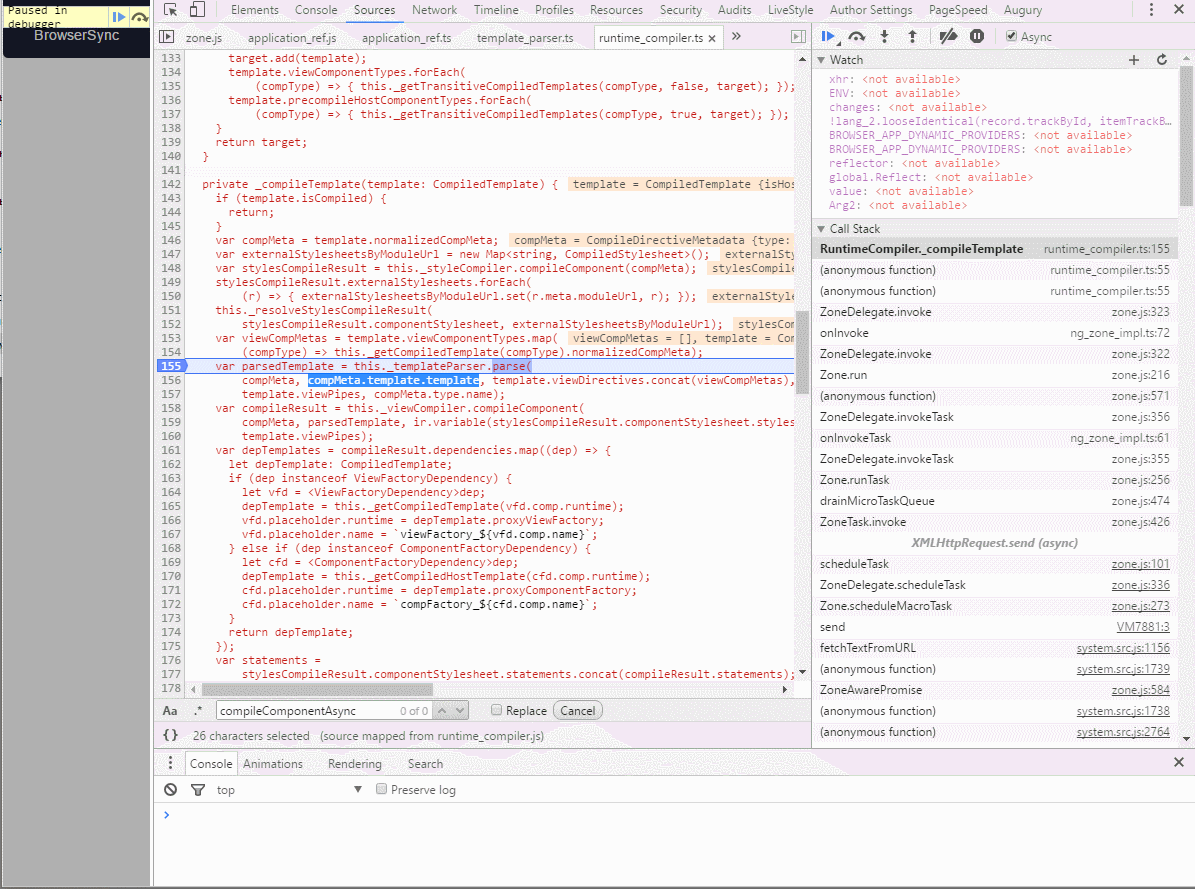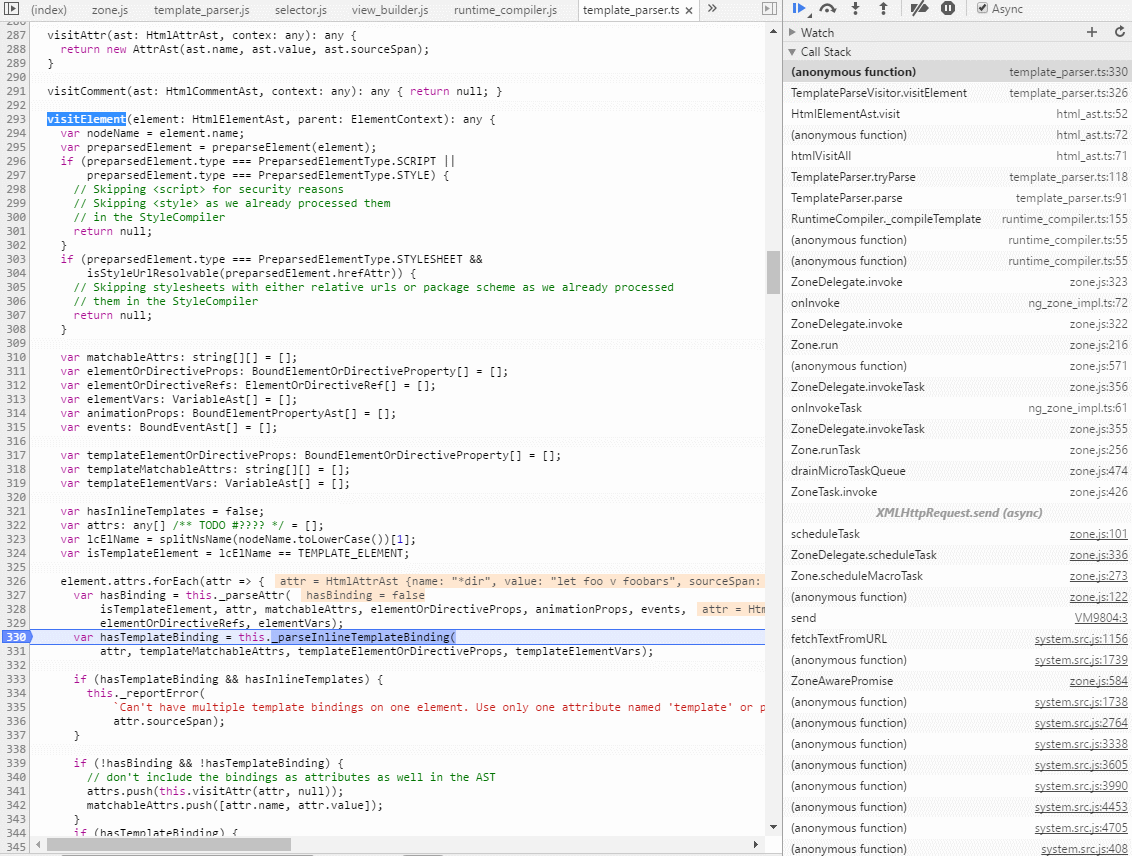Angular2:ngfor如何扩展
我知道<div *ngFor="let foo of foobars">{{foo.stuff}}</div>上的教科书规则变为<template ngFor let-foo="$implicit" [ngForOf]="foobars"><div>...</div></template>。我的问题有两方面:
- 如何吗
- 我自己需要做些什么才能利用这种机制(&#34; microsyntax&#34;)?
即将<div *myDirective="item">{{item.stuff}}</div>转变为<template myDirective let-item="$implicit"><div>{{item.stuff}}</div></template>?
由于我从上到下阅读了ngFor的源代码,我只能假设这个黑魔法在编译器的某个地方,我已经在角度github上下,但我不能把手指放在上面。 帮助!
2 个答案:
答案 0 :(得分:13)
是的,所有的魔法都发生在编译器中。
让我们来看看这个模板:
<div *ngFor="let foo of foobars">{{foo}}</div>
首先它将转换为以下内容:
<div template="ngFor let foo of foobars>{{foo}}</div>
然后:
<template ngFor let-foo [ngForOf]="foobars"><div>{{foo}}</div></template>
首先生成ast树节点(抽象语法树节点)然后所有魔法发生在TemplateParseVisitor.visitElement(https://github.com/angular/angular/blob/2.0.0-rc.4/modules/%40angular/compiler/src/template_parser.ts#L284)特别是底部(https://github.com/angular/angular/blob/2.0.0-rc.4/modules/%40angular/compiler/src/template_parser.ts#L394)
if (hasInlineTemplates) {
var templateCssSelector = createElementCssSelector(TEMPLATE_ELEMENT, templateMatchableAttrs);
var templateDirectiveMetas = this._parseDirectives(this.selectorMatcher, templateCssSelector);
var templateDirectiveAsts = this._createDirectiveAsts(
true, element.name, templateDirectiveMetas, templateElementOrDirectiveProps, [],
element.sourceSpan, []);
var templateElementProps: BoundElementPropertyAst[] = this._createElementPropertyAsts(
element.name, templateElementOrDirectiveProps, templateDirectiveAsts);
this._assertNoComponentsNorElementBindingsOnTemplate(
templateDirectiveAsts, templateElementProps, element.sourceSpan);
var templateProviderContext = new ProviderElementContext(
this.providerViewContext, parent.providerContext, parent.isTemplateElement,
templateDirectiveAsts, [], [], element.sourceSpan);
templateProviderContext.afterElement();
parsedElement = new EmbeddedTemplateAst(
[], [], [], templateElementVars, templateProviderContext.transformedDirectiveAsts,
templateProviderContext.transformProviders,
templateProviderContext.transformedHasViewContainer, [parsedElement], ngContentIndex,
element.sourceSpan);
}
return parsedElement;
此方法返回EmbeddedTemplateAst。它与:
<template ngFor let-foo [ngForOf]="foobars"><div>{{foo}}</div></template>
如果你想转:
<div *myDirective="item">{{item.stuff}}</div>
到
<template myDirective let-item><div>{{item.stuff}}</div></template>
然后您需要使用以下语法:
<div *myDirective="let item">{{item.stuff}}</div>
但在这种情况下,你不会传递上下文。 您的自定义结构指令可能如下所示:
@Directive({
selector: '[myDirective]'
})
export class MyDirective {
constructor(
private _viewContainer: ViewContainerRef,
private _templateRef: TemplateRef<any>) {}
@Input() set myDirective(prop: Object) {
this._viewContainer.clear();
this._viewContainer.createEmbeddedView(this._templateRef, prop); <== pass context
}
}
您可以像以下一样使用它:
<div *myDirective="item">{{item.stuff}}</div>
||
\/
<div template="myDirective:item">{{item.stuff}}</div>
||
\/
<template [myDirective]="item">
<div>{{item.stuff}}</div>
</template>
我希望这有助于您了解结构指令的工作原理。
<强>更新
让我们看看它是如何运作的( plunker )
*dir="let foo v foobars" => [dirV]="foobars"
所以你可以编写以下指令:
@Directive({
selector: '[dir]'
})
export class MyDirective {
@Input()
dirV: any;
@Input()
dirK: any;
ngAfterViewInit() {
console.log(this.dirV, this.dirK);
}
}
@Component({
selector: 'my-app',
template: `<h1>Angular 2 Systemjs start</h1>
<div *dir="let foo v foobars k arr">{ foo }</div>
`,
directives: [MyDirective]
})
export class AppComponent {
foobars = [1, 2, 3];
arr = [3,4,5]
}
以下是相应的 Plunker
另见
- https://angular.io/docs/ts/latest/guide/structural-directives.html#!#the-asterisk-effect
- https://teropa.info/blog/2016/03/06/writing-an-angular-2-template-directive.html
- https://www.bennadel.com/blog/3076-creating-an-index-loop-structural-directive-in-angular-2-beta-14.htm
- https://egghead.io/lessons/angular-2-write-a-structural-directive-in-angular-2
您可以在此处找到实时示例https://alexzuza.github.io/enjoy-ng-parser/
答案 1 :(得分:0)
UILocalNotification *localNotification = [[UILocalNotification alloc] init];
localNotification.fireDate = [NSDate dateWithTimeIntervalSinceNow:10];
localNotification.alertTitle = @"Welcome";
localNotification.alertBody = @"Thank You for installing Application";
localNotification.soundName = UILocalNotificationDefaultSoundName;
localNotification.timeZone = [NSTimeZone defaultTimeZone];
[[UIApplication sharedApplication] scheduleLocalNotification:localNotification];
,*ngFor,...是结构指令。
将其应用于*ngIf元素,或以<template>
https://angular.io/docs/ts/latest/guide/structural-directives.html#!#unless
*
- 我写了这段代码,但我无法理解我的错误
- 我无法从一个代码实例的列表中删除 None 值,但我可以在另一个实例中。为什么它适用于一个细分市场而不适用于另一个细分市场?
- 是否有可能使 loadstring 不可能等于打印?卢阿
- java中的random.expovariate()
- Appscript 通过会议在 Google 日历中发送电子邮件和创建活动
- 为什么我的 Onclick 箭头功能在 React 中不起作用?
- 在此代码中是否有使用“this”的替代方法?
- 在 SQL Server 和 PostgreSQL 上查询,我如何从第一个表获得第二个表的可视化
- 每千个数字得到
- 更新了城市边界 KML 文件的来源?

